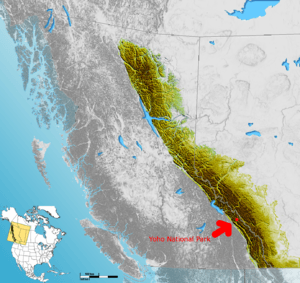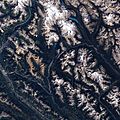Burgess Shale facts for kids
Quick facts for kids Burgess ShaleStratigraphic range: Miaolingian ~508Ma |
|
|---|---|

Ottoia, a soft-bodied worm, abundant in the Burgess Shale. (From Smith et al. 2015)
|
|
| Type | Geological formation |
| Unit of | Stephen Formation |
| Thickness | 161 meters (528 ft) |
| Lithology | |
| Primary | Shale |
| Location | |
| Coordinates | 51°26′N 116°28′W / 51.433°N 116.467°W |
| Region | Yoho National Park and Kootenay National Park |
| Country | Canada |
| Type section | |
| Named for | Burgess Pass |
| Named by | Charles Doolittle Walcott, 1911 |
 Map highlighting Yoho National Park in red |
|
The Burgess Shale Formation in the Rocky Mountains of British Columbia is one of the world's most celebrated fossil fields, and the best of its kind. It is famous for the exceptional preservation of the soft parts of its fossils. It is ~505 million years old (Middle Cambrian), one of the earliest soft-parts fossil beds.
The rock unit is a black shale, and crops out at a number of localities near the town of Field in the Yoho National Park.
The Burgess Shale was discovered by palaeontologist Charles Doolittle Walcott in 1909, towards the end of the season's fieldwork. He returned in 1910 with his sons, and established a quarry on the flanks of Fossil Ridge. The fact that fossils were of soft-bodied forms, and the range of organisms new to science, led him to return to the quarry almost every year until 1924. At this point, aged 74, he had amassed over 65,000 specimens.
Describing the fossils is a vast task, pursued by Walcott until his death in 1927, and continued into the 21st century. Walcott, led by scientific opinion at the time, attempted to categorise all fossils into living taxa. As a result, the fossils were regarded as little more than curiosities at the time. It was not until 1962 that a first-hand reinvestigation of the fossils was attempted, by Alberto Simonetta. This led scientists to recognise that Walcott had barely scratched the surface of information available in the Burgess Shale.
A second quarry (in the same geological formation) was opened. A thorough reassessment of the Burgess Shale showed that the fauna were much more varied and unusual than Walcott had realised. The Royal Ontario Museum now has the largest collection of Burgess Shale material in the world with over 150,000 specimens. Many of the animals present had bizarre anatomical features and only the slightest resemblance to other known animals. Examples include Opabinia, with five eyes and a snout like a vacuum cleaner hose; Nectocaris, and Hallucigenia. This last was originally reconstructed upside down, walking on its spines.
The Burgess Shale was designated a UNESCO World Heritage Site in 1980. It became part of the Canada Rocky Mountain Parks World Heritage Site in 1984.
Related pages
Images for kids
-
The first complete Anomalocaris fossil found.
-
Satellite image of the area.
See also
 In Spanish: Esquisto de Burgess para niños
In Spanish: Esquisto de Burgess para niños




